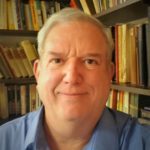By Curt Collier

It started out as a day like any other day. Our trailer park had originally been a World War II training facility, and there were evenly spaced rows of concrete slabs where Quonset huts had once stood. These now supported a hodgepodge collection of mobile homes, including my family’s. In between were some dry patches of grass that barely survived the harsh dry seasons in southwest Texas. Here is where my brother and I could be routinely found playing some sporty game with our friends, Paul and Natchez Garcia. Their sisters, Lucy and Irene, were nearby, as they always were. It was then that my father ran out the door saying my own sister had been in some kind of accident.
My brother Allan and I didn’t know what to do, nor did we know what happened as my father drove away to collect my mother and rush her to our small county hospital. Always a ball in his hand, Allan began to nervously bounce the ball to me as we waited outside on the slab for our parents to return. A few hours later, they did arrive, both in distress, to say our sister Diane had been killed in an accident involving her boyfriend’s pickup. She was 16 years of age.
We buried my sister
What happened next is something of a blur to me. I remember what seemed like the entire city came to our humble home, and there were piles of food wrapped in aluminum foil or in Tupperware containers that covered every inch of the counters and fridge. The local priest dropped by and told my grieving mother that Diane was with God now. I remember my mother responding through tears, “She should be here with me.” After we buried my sister the day of my 13th birthday, I never saw the priest again.
The next few months were horrific, to say the least, as my family went through one of the darkest periods of our lives. The emotional strain invaded our days and nights. For a couple of months afterward, my mom reported having similar dreams, such as being in a place and suddenly engulfed by dark clouds. She then began to report that she could feel my sister’s presence invading her dreams in our trailer at night, which, as you can imagine, was frightening to us all. She said that she could feel her moving down the hall toward her bedroom, but each time my mom would wake up screaming. Finally, one night, she told us that Diane had come again and that she had to confront her. Once again, she reported becoming aware of my sister’s presence in the home. She reported feeling terror as the apparition moved down the hallway, slowly opening the door to her bedroom, and standing at the foot of the bed. My mom tearfully said to the spirit, “Diane, I love you, but you’re dead.” The apparition nodded, threw a package of tomato seeds on the bed, and departed. Mom never had nightmares again, but to this day, I still hesitate when I see a package of tomato seeds.

The tremendous sadness nearly destroyed all of us, so my parents made a daring choice. A few months before my sister’s death, my parents had bought a few acres of land near Castroville, Texas, in a place that had once been a cattle ranch. They made the decision to get out of the trailer park, leave Hondo, and move onto the land. Without so much as running water or electricity, move we did that next summer, living first in a tent while they ordered a new trailer home. The place was loaded with prickly-pear cactus, thorny mesquite trees, sharp-edged agarita bushes, and other tough plants typically found on the edge of the Chihuahua desert.
Nature heals, I can attest to that
For the next several years, we worked the land every day, trying to carve out a space to live in the thick chaparral. Despite the years of sadness that followed, something about that experience saved us all. Our little dusty patch of land blossomed into a garden or sorts. To this day, I can still smell the mesquite wood and sweet smell of cactus apples. I see Inca dove taking dirt baths in the shade of thorny Huisache trees, and that bit of beauty will be forever edged in my mind. Nature heals, I can attest to that, and for the past 20 years, I’ve been working to ensure that everyone has a bit of green, a place of healing and solace. No doubt you have yours, as well.
Finding that space may be easier in tonier, green New Jersey neighborhoods, but for many urban youth growing up in the dense urban environments nearby, finding that healing space is very difficult. That’s why it is so important to have a bit of green within easy walking distance of most neighborhoods, and our work is to help reclaim abused land covered in landfill and return it to parkland. The challenge is getting young adults and families to connect with what may have been a former landfill.
Help us understand places of attachment
I know from my previous work that what is needed to preserve green space in urban America is a connection to that place, but that doesn’t happen magically. What leads to place attachment? What constitutes a safe green haven? How do people view a former landfill now as a place of natural wonder?
I posed this very question to the New Jersey Council of the Humanities, and luckily, we won a $6,500 grant to study that very question. We’re pulling together a group of nonprofits, community stakeholders, and people like you to study the research on place attachment. If you have interest, I surely would love you to join our study group. We’re calling the project “Through These Gates,” a nod to the Japanese practice of putting Tori gates before natural wonders to remind people that something special is happening in that location. Please consider joining the conversation and being a part of the study group. We’d love to hear your own insights and, collectively, we might just find new ways to bring others into a place of healing.
Curt Collier is leader of the Ethical Culture Society of Bergen County.
Note: The organizing meeting of “Through These Gates” is Thursday, April 6, 11 am at the meetinghouse. Lunch will be provided.
